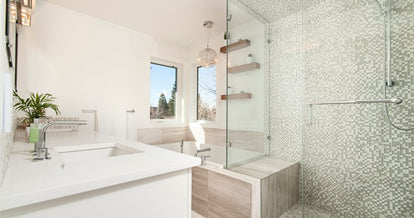
How To Seal A Bathroom
Posted on 05 July, 2021
Sealing your bathroom is key when you want to stop water penetration into joints around basins, baths and showers. In this guide, we’re going to look at how to seal different areas of your bathroom.
What You Need
- Sealant Softener
- Plastic Scraper
- Bathroom Cleaner
- Sealant
- Round-Ended Tool
- White Spirit
- Tape Measure
- Reinforcing Membrane
- Craft Knife
- Liquid Waterproofing
- Paint Brush
- Trowel
- Electric Drill
How to seal a bathtub
- If the sealant around your bathtub is looking a little worse for wear, adding new sealant isn’t a big task. To remove old sealant, use a sealant softener and leave to dry for around 15 minutes. Remove the sealant using a plastic scraper, take care with this – you don’t want to damage the bath. Scrub the area using a bathroom cleaner and leave it to dry.
- Once the sealant has been removed, fill the bath with water. This added weight will ensure that the sealant won’t crack when the bath is used later. Place the sealant cartridge into the gun and cut the nozzle off to a size that suits the gap that needs to be filled. Press the trigger and apply the sealant in one smooth movement. Once it is applied, smooth with a round-ended tool and shape the sealant at an angle to help shed water.
- Remove any excess sealant with white spirit before it dries and leave the sealant to dry fully before emptying the bath.
Waterproofing a shower
- When installing a new shower, waterproofing is obviously an integral part! A watertight seal must be created that stops water from leaking into the small wall joints and floorboards, which could cause structural issues and rot. Once the walls of the shower are built, a mix of a liquid adhesive and reinforcing membrane is the key to creating a shower that’s immune to water damage.
- Mark the areas where you want to waterproof, measuring the shower stall and using a pencil to mark the exact dimensions along the backing board. Using a stripe of painter’s tape, create an outline which will clearly show where waterproof materials are needed. We recommend adding an extra inch to your waterproofing area, just to be on the safe side!
- Measure and cut a roll of reinforcing membrane to fit over the walls. Mark any key fixtures on the membrane including the valve, shower head and temperature knobs. Cut the membrane into long, thin strips that will fit the corners where the shower walls meet. This membrane will provide an extra layer of water-stopping protection thanks to the tightly woven fabrics used.
- Once the membrane is cut to the right size, create cross-shaped slits in the membrane to accommodate the fixtures. When you install these fixtures later, you should easily be able to fit them in place over the membrane without losing valuable waterproofing space. We recommend using a craft knife or Xacto knife for this.
- Apply a coat of liquid waterproofing to the backing board using a paintbrush with high-quality bristles. Create a thick, even coat across the whole wall with no gaps.
- Carefully place the pre-cut membrane on to the wall, starting at the top. Use the flat side of a trowel to work out any creases or air bubbles.
- Apply the final coat of waterproofing over the top of the membrane, again aiming for a thick coat. Focus attention on corners and any other areas where the membrane meets.
- Let the waterproofing dry by fully ventilating the room. This could take several hours so be careful not to touch the materials during this time!
How to seal a shower tray
Shower trays are typically included in shower installation kits and come pre-sized and ready to be installed. Let’s take a look at how to make sure your shower tray is sealed and ready to go.
- Place the tray on top of the subflooring at the base of the shower stall. Use the circular template included with the kit to make a mark or notch where the drain will be centred. Take care to place the opening for the drain on the same side that the showerhead will be on.
- Using an electric drill, place the drill head flush against the subflooring and begin drilling – ensure constant pressure is used all the way through. Wipe down the flooring to get rid of any debris.
- Using the same techniques as you did with the shower walls, spread waterproofing all over the floor tray, aiming for a thick coat.
- Place reinforcing membrane over the floor and surrounding area, taking care to lay strips over the cracks where the walls and the floor connect. Measure a hole to fit over the drain opening and finish by applying a final coat of waterproofing over the entire floor.
- Once the waterproofing is dry, you’re ready to add a tile or acrylic floor liner to your fully waterproofed shower!
For all the tools you need to complete a waterproofing project in your bathroom, take a look at the BC Profiles sealant range. From tanking membrane installation to full wet room systems, sealants, dust sheets and more, we have everything you need to get the job done.